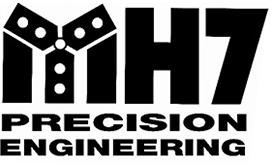Back in 1989 when Mark Hirst set up MH7 Engineering in Brighouse, West Yorkshire, with just a turret mill, centre lathe and an old Ward 7 turret lathe. His ambition at the time was simply to provide a niche service to all of the local manufacturing companies who were getting rid of their own toolrooms and maintenance facilities. Now, 26 years later, he still provides a service to machine one-off parts for machine breakdowns and the occasional mould tool, but MH7 has diversified into general sub-contracting and specialist manufacture of parts for anything from workholding fixtures, through racing car wheels to soap extrusion systems!
“Our core focus still remains the low volume, one-off, end of the market where we can use our toolroom skills to get our teeth into specific problems and challenges. This has given us extensive experience of many different industries, and we have been able to transfer the needs of one industry to another, providing solutions that others may not have come up with,” says Mark Hirst. In addition to the toolroom type of work MH7 also takes on precision sub-contract work and provides a design service to those customers that require it. This has led to some intricate and unusual components being machined.
Along the way this diversification has meant investment in machine tools and as well as gear cutting and EDM equipment for specialist odd-job work MH7 has also brought in a number of more conventional machines, in the form of XYZ ProTURN lathes, one with a 3 metre bed length, an XYZ Minimill560, an XYZ 1510 vertical machining centre with fourth axis capability and most recently an XYZ 1020 vertical machining centre. “We purchased our first ProTURN lathe before we had any CNC machines and the ProtoTRAK control was a good introduction, that has allowed us to progress from there and it is particularly suited to the type of work that we do. The initial ProTURN lathe we bought was specified with a 3 metre bed, which we bought on spec as we didn’t have any work of that length at the time.
Now that we have experience of the ProtoTRAK control and also the Siemens on the XYZ machining centres, our next move will be to go full CNC with an XYZ lathe to supplement our existing capacity,” says Mark Hirst.
The XYZ vertical machining centres are also being used to maximise the capabilities of MH7, especially the XYZ 1510 with the fourth axis option. A recent project to machine a burner exit adaptor in 316 stainless from a billet was completed on the XYZ 1510 with ease. Another customer required some complex milling to be completed on an outlet to be used for testing turbochargers. Slightly less exotic, but forming a regular source of work for MH7 is the work it does for workholding specialist John Walton, in particular it manufactures a number of specialist Rock Steady work steadies, many of which end up back with XYZ for use on its XL range of large capacity lathes. These range in size from what could be classed as conventional three-point steadies through to a one-off, gear driven, four point steady recently completed by MH7.
The XYZ machines have made the manufacture of all of the parts that MH7 machine that much easier, due to the versatility of the machines and the ease of use of both the ProtoTRAK control on the lathes and the Siemens 828D ShopMill Control on the vertical machining centres. An example of this is where Mark Hirst takes advantage of the user-friendliness of the machines, when machining one-off components for his collection of motorcycles, including a Coventry Eagle Flying 8, which he rebuilt from a box full of bits. Mark machined a variety of parts such as push rods, engine casings, spindles and gears on the XYZ machining centres and lathes.
The ongoing customer service provided by XYZ is also an important aspect in Mark Hirst’s decision to keep buying from XYZ: “Given the nature of the work that we do we are often under serious time constraints and it is reassuring that we can simply pick up the phone to XYZ and they will deal with any problems we have that way if possible, providing ongoing support for programming issues as well as talking us through any machine issues, allowing us to get a problem solved without having to wait for an engineer on the rare occasions we need that support. If I didn’t like the XYZ machines, I wouldn’t keep buying them!”
